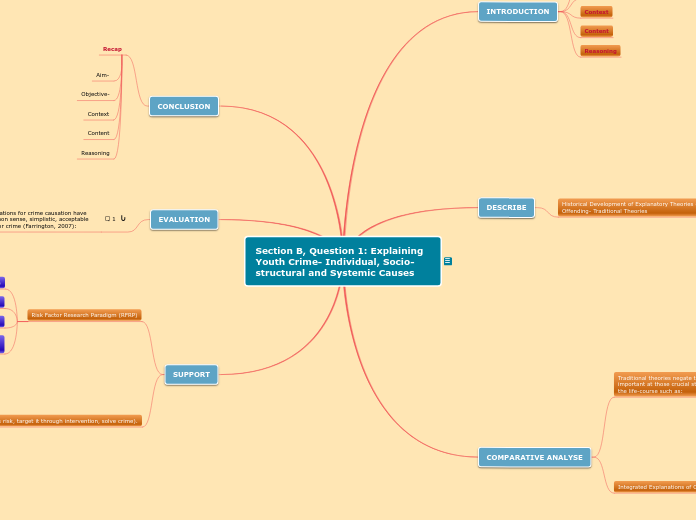This discourse has given rise to two central concepts:
1. Trajectories- “a pathway or line of development over the life span” (Sampson and Laud, 1993:8).
2. Transitions- life events which bring about short-term changes in social roles within long-term trajectories
Section B, Question 1: Explaining Youth Crime- Individual, Socio-structural and Systemic Causes
The map relates to Section B, Question 1 of the YODD Exam:
Explaining Youth Crime- Individual, Socio-structural and Systemic Causes
Specifically, the exam area examines the role of individualistic theories in explaining youth crime.What propels youths to commit delinquency is often a complex interplay of a variety of biological, genetic, and environmental factors which is further complicated by various reactions to environmental factors.
The ‘triad of youth justice’ (Case, 2018:2) reveals that the nature of ‘Youth Offending’ is defined and revised over time through the activities of various social, cultural, economic, political, professional, academic and media influences. It is shaped by how a society chooses to define (construct) ‘youth offending’ at any given point in time, which in turn can influence how youth offending is explained, which in turn can influence how it is responded to through the philosophies, systems, structures, strategies, processes and practices that constitute youth justice- construction of ‘childhood’. Definitions, explanations and responses as three interrelated and mutually-reinforcing elements working together in the social construction of youth offending and youth justice responses to it!
Over the last 200 years, a series of explanatory theories have been advocated which seek to identify-
•Causes
•Influences
•Predictors
•correlates
A significant number of these theories have privileged the study of young, working-class, white males as the archetypal ‘offender’. As a result, it is important to explore their limitations due to their implicit, “androcentric, ethnocentric and class-centric biases” (Case, 2018:51).
These dominant theories have been utilized to inform and shape the way we conceive of youth offending and have helped to shape youth justice responses tom it. As such, it is important to explore their validity!
The question requires you to:
- Identify the historical development of explanatory theories of youth offending.
- Acknowledge the plethora of criminological theories of juvenile delinquency.
- Analyse individual explanations of offending.
- Compare socio-structural explanations of crime.
- Evaluate the influence of integrated theories on explanations of youth crime
SUPPORT
Assess risk, target it through intervention, solve crime).
Test their validity and the common claims they make:
You
will want to evaluate theories using the following questions:
Author:
- Who is the theorist?
- Why should I believe what he or she has to say on the topic?
Current:
- How current is the theory?
- When was it published?
- Is the information out-of-date?
Accuracy:
- Is the content accurate?
- Is the information presented objectively?
- Do they share the pros and cons?
The approach has come to dominate assessment, planning and intervention tools for the identification of ‘factors’ in an attempt to predict ‘risk’
Onset
Asset
AssetPlus
Focus of both assessment and intervention shifted from the child to the general environment, the family, and the school environment.
The readily understandable findings of RFR have now become embedded in the Youth Justice system in terms of policy and practice and a ready set of targets for intervention.
Risk Factor Research Paradigm (RFRP)
Age-Graded Theory of Informal Social Control (Sampson and Laub, 1993)
Dual Taxonomy (Moffitt, 1990)
The Criminal Career Model (West and Farrington, 1973)
Multi-Factor Developmental Theory (Glueck and Glueck, 1930)
EVALUATION
RFR assert that their explanations for crime causation have validity- that they are common sense, simplistic, acceptable and practical explanations for crime (Farrington, 2007):
In other words, the globally applicable concept of ‘risk factors’ and ‘protective factors’ has resulted in:
- An oversimplification of risk
- a confidence in positivistic RFR
- A ‘Riskfactorology’
Risk factor research is diverse, theoretically and methodologically- however, such differences are under-explained or even ignored and as such their consequences have remained hidden from understanding. Such oversimplified conclusions are then adopted by politicians, policy makers,
which exacerbates the problem. Laub (2006) suggests that Criminologists
ignore ‘key facts’ that run contrary to own theoretical predictions.
Incestuous, pseudo-psychological, Americanised, over-simplified and dehumanising. Privileging this model to the relative exclusion of alternatives (e.g. actually talking to children about their experiences and understandings) ” (2016: online):
Case (2016: online) suggests the ‘evidence’ comes from an endless stream of self-fulfilling, repetitive risk factor research studies and experimental, risk-based ‘what works interventions.
CONCLUSION
Recap
COMPARATIVE ANALYSE
Integrated Explanations of Crime
Such theories mix, merge and fuse together concepts, arguments, research methods, evidence and explanations from more than one criminological theory:
-Within-theory
-Within-School
-Between-School
Socio-Political Context
According to Case et al, (2017), this:
“socio-political risk perspective began to gain popularity within criminology in the industrialised western world” (2017:511).
Integrated Risk Factor Theories
Enhanced Pathways Risk Factor Theories
Artefactual Risk Factor Theories
Integrated Positivist Theories
Social Control theories of crime
Sociobiological theories
Traditional theories negate the varying factors that are important at those crucial stages of development throughout the life-course such as:
Integrated risk factors theories are
arguably the hegemonic explanatory theories within criminology today- because
they have a particular way of conceptualising the causes of an influences on
crime- essentially through the simplistic quantification and measurement in
early life of factors that are assumed to predict future offending.
Intertwining of personal factors, social factors, socialization factors, cognitive factors, and situational factors
How early childhood experiences and family experiences can impact on later behaviour.
DESCRIBE
Historical Development of Explanatory Theories of Youth Offending- Traditional Theories
The strength of such ‘grand theories’ of crime had been the high level of empirical/evidential support due to the broad range of influences on crime considered by social control theories when compared to single factor or single school theories- however, they are unable to explain all crimes at all times.
The claims made by such ‘grand theories’ are now challenged by the prominent rise of artefactual risk factor theories.
Critical Explanations
Draws on the concept of 'Power'- "By pointing to power without analyzing its class basis and the nature of the state, [the sociologists of deviance and labeling theorists] transformed the actions of the powerful into an arbitrary flexing of muscle" (Young, 1978:13).
Labelling
Focus is on the activities of the powerless whilst obscuring their ability to exploit their own privileged position.
Crime as the product of socio-political conditions which are influenced by the political interests of those who seek to maintain their position.
Structural inequalities becomes institutionalized within the operation of the law and the wider working of the state.
Critical Theories
Power to evade criminalisation.
Power to Criminalise/De-criminalise certain forms of behaviour.
Socio-structural Explanations
Positivism
Offered deterministic explanations of offending and perceived the offender as a predetermined actor (someone whose actions are predestined following exposure to certain influences).
Biological positivist theories mainly focused on the criminogenic potential of physical characteristics and genetic inheritance, moving towards latterly,
neuroscientific considerations of the role of brain development.
Crime occurs due to determined factors at the sociological and psychological levels.
Individual Explanations
Biological Positivism-
Crime can be treated and the individual rehabilitated.
Crime occurs due to determined factors at the physiological level and biological levels.
Classicism-
Have reconstructed the role of free will/rational choice as only one element of more holistic, multi-factor, integrated explanations- it is these which we will
explore in more detail. Linked to contemporary situational crime prevention.
Views ‘free will’ and ‘rational choice’ as mitigated (made less influential) by other factors in the lives of ‘vulnerable’ groups such as children, the mentally ill and the learning disabled (e.g. Akers, 1991: Wilson and Hernstein, 1985). As such- neo-classical explanations offer a compromise position between classical and individual positivist theories.
Gives rise to crime control strategies.
Crime occurs due to 'rational choice'
INTRODUCTION
Reasoning
Content
Context
Objective-
Aim-









